Bitter Pill
by Timothy Reichert
First Things Magazine
May 2010
Introduction
Economists and other social scientists have written extensively about
the impact that contraception has had on modern sexual relationships.
Almost without exception, the academic establishment makes the claim
that contraceptive technology is a social good. By contrast, the
Catholic Church (and until recent decades the Christian establishment
generally) asserts that the practice of contraception is, in fact,
directly contrary to the health of individual families and to society
as a whole.
The difference between these two perspectives on an issue that is
central to human sexuality—and therefore human existence—is striking.
But meaningful debate between the two camps has been almost
nonexistent. Certainly, part of the reason for this has been an
unwillingness on the part of secular social scientists to engage in
honest dialogue. But an equally large part of the blame for the
nonengagement should be laid at the feet of Catholics. With a few
notable exceptions, the Catholic perspective has not been taken
seriously by Catholics themselves. Nor, in the cases when it has, has
it been articulated using the language of social science, which is the
language of the mainstream. As a result, the difference in viewpoint on
an issue that is central to the human person is treated by our culture
as a case of faith and reason talking past each other.
With this essay, using the language and tools of modern social science,
I will articulate the position that contraception is socially damaging.
I will also demonstrate that contraception is in fact a sexist
practice. Using straightforward microeconomic reasoning, I will unpack
the behaviors engendered by artificial contraception. I will show that
the contraceptive revolution has resulted in a massive redistribution
of wealth and power from women and children to men.
In doing so, I will reveal that despite the ethical inferiority of
artificial contraception, the practice of contraception will,
unfortunately, predominate as the social “equilibrium”—unless legal
restrictions or social mores “tax” men and “subsidize” women and
children. More technically, artificial contraception sets up what
economists call a “prisoner’s-dilemma” game, in which each woman is
induced to make decisions rationally that ultimately make her, and all
women, worse off. This result is particularly striking and has broad
implications for how we think about the sexual revolution and its
aftermath.
The Basic Economics
of Contraception
Marriageable Men Become
Scarce—and Women Pay More for Them.
Economists view social phenomena through the lens of markets. This does
not mean that economists believe that all social interaction is, in
fact, coordinated through explicit cash pricing. Rather, it means that
economists recognize that relative scarcity or abundance affects
behavior in important ways.
Economists are trained to use a set of reasoning tools to identify and
explain the sometimes subtle ways in which, for example, new
technologies (such as chemical contraception) or other fundamental
changes unfold themselves into much broader social dynamics.
What are the social processes that should be logically included under
the rubric of contraception? First and foremost, contraception divides
what was once a single mating “market,” wherein men and women paired in
marriage, into two separate markets—a market for sexual relationships
that most people now frequent during the early phase of their adult
lifetimes (I will refer to this as the “sex market”), and a market for
marital relationships that is inhabited during the later phases (I will
refer to this as the “marriage market”).
Obviously, contraceptive technology provides the assurance that
participation in the sex market will not result in pregnancy. It
therefore lowers the costs of pre-marital and extramarital sexual
activity below the level necessary for a separate sex market to form.
Data compiled by Betsey Stevenson and Justin Wolfers of the Wharton
School at the University of Pennsylvania show a marked decrease in
participation in the marriage market, at ages 15 to 60, over the forty
year period from 1960 to 2000. Their graph, below, shows that, for
example, the percentage of Americans married at age 30 fell from
roughly 85 percent in 1960 to roughly 60 percent in 2000. Assuming that
sexual activity has not decreased over the same period (clearly a safe
assumption), this implies increased participation in the sex market
over the same period.
Work by Harvard economists Claudia Goldin and Lawrence Katz bears this
out. Their graphs (opposite) show a marked decrease over time in
women’s participation in the marriage market at ages 20 through 30, and
a corresponding increase in their participation in the sex market.
Marital
Participation by Age
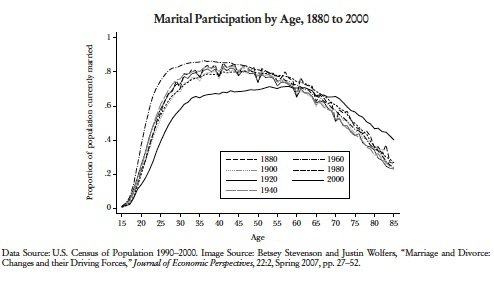
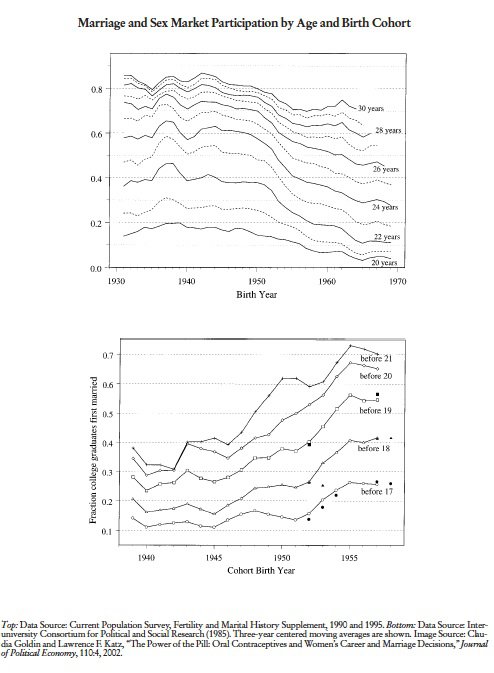
This separation of a single mating market into two separate markets—the
sex market and the marriage market—is not necessarily adverse to either
women or men. It is only when imbalances exist in these markets that
the “price” of either marriage or sex tilts in favor of one or the
other gender. In other words, whereas the marriage market was, by
definition, populated by roughly the same number of men as women, there
is no guarantee that once it has been separated into two markets, men
and women will sort themselves into the sex and marriage markets in
such a way that roughly equal numbers of each gender will inhabit each
market.
It may be biologically inevitable that relatively more men will
populate the sex market and relatively more women will populate the
marriage market. The reason for this is simple. The vast majority of
women want to have children sometime during their lives. This can
happen only before menopause, and if women want to ensure higher levels
of fitness for their children, it should happen well before that.
Further, prospective mothers recognize that stable marriage is far more
preferable for the well-being of their children than is cohabitation or
single parenting. This means that before a certain age—usually sometime
in their early thirties at the latest—most women will inhabit the
marriage market rather than the sex market.
By contrast, men face no such constraints. Men can reproduce at very
late stages in their life cycle. This means that men do not face the
same time pressure that women do to move out of the sex market and into
the marriage market.
The notion that more men than women will populate the sex market is
also supported by evolutionary biology—a field closely related to
microeconomics. Men and women have different approaches to sex and
marriage. Women take nine months to make a baby, while it takes a man
about ten minutes. As the evolutionary biologist Robert Trivers has
pointed out, this simple biological fact, in conjunction with the force
of natural selection, lies behind the commonsense notion that males are
always available for sex. Men invest very little to spread their genes.
For females, by contrast, sex leads to pregnancy, which leads to a
lifelong commitment of time and resources.
The implications are straightforward. The average age at which men exit
the sex market and enter the marriage market is higher than the average
age at which women make the same decision. This, in turn, means that at
each point in time, more men will inhabit the sex market than women.
Correspondingly, more women will inhabit the marriage market than men.
The result is easy to see. From the perspective of women, the sex
market is one in which they have more bargaining power than men. They
are the scarce commodity in this market and can command higher “prices”
than men while inhabiting it.
But the picture is very different once these same women make the switch
to the marriage market. The relative scarcity of marriageable men means
that the competition among women for marriageable men is far fiercer
than that faced by prior generations of women. Over time, this means
that the “deals they cut” become worse for them and better for men.
The institution of marriage shifts from an institution that was
motivated (at least in part) by the need to protect and foster women
and the children they bear, to an institution that is motivated more by
what Stevenson and Wolfers call “joint consumption.” In practice, this
means that marriage moves from something resembling a contractual
arrangement to something that is, instead, more frail and resembles a
spot market exchange. The day-to-day aspects of marriage shift
relatively toward the welfare of men, and relatively away from the
welfare of women and their children. In short, men take more and more
of the “gains from trade” that marriage creates, and women take fewer
and fewer.
The Implications of
Scarcity
The immediate implication of the separation of the mating market into
sex and marriage markets is that women generally will have a strong
bargaining position relative to men when coupling in the sex market,
because of their relative scarcity, but later will have a weak relative
bargaining position in the marriage market, because of the relative
scarcity of men in this market.
This produces a redistribution of bargaining power and, ultimately, of
welfare from the later childrearing phases of a woman’s lifetime toward
the earlier, and in my view less important, phases. This redistribution
has some very concrete, very undesirable consequences for women—and for
the children that they bear.
Specifically, from the bifurcation of the mating market into separate
sex and marriage markets come several self-reinforcing processes.
Foremost among these is that contraception inevitably leads to more
divorce.
There are two reasons for this. First, because of the lower relative
bargaining power that women wield relative to men in the marriage
market, at the margin more women will simply strike “bad deals” and
will want a way out of the marital covenant ex post . In the era before
contraception, roughly equal numbers of women and men in the marriage
market meant that men and women roughly split the gains from trade that
stem from marriage. By contrast, in the postcontraceptive era women
give away many, indeed most, of these gains to men. This lower level of
“surplus,” or marital benefit, for women means that there is precious
little room in the course of their marriages for downside. In other
words, when things go wrong relative to what was expected, women who
expected to be somewhat better off because of the gains from marriage
now find themselves in a position of being worse off within marriage
than they would have been as single persons. This, in turn, leads quite
naturally to an increase in the demand for divorce ex post .
Female Law and
Medical School Participation
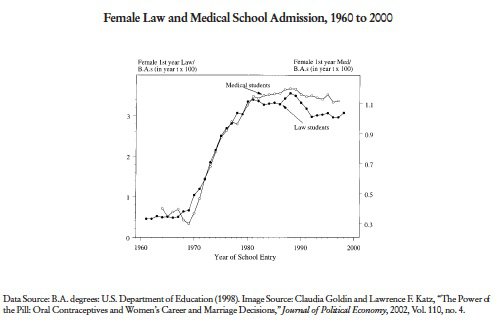
Second, there is a closely related “demand for divorce” before marriage
even occurs. That is, there is now an ex ante demand for divorce in the
form of a premarriage exit option. In other words, women now demand,
before marriage, an exit option just in case things turn out badly.
At the level of culture, women demand this option by allowing the
strictures and social mores surrounding divorce to erode. Divorce no
longer carries with it any kind of stigma because the women among us
who formerly would have created this stigma recognize that having the
option is now in their interest, too.
At the level of politics women do the same by allowing, and sometimes
organizing on behalf of, laws such as no-fault divorce laws.
Rationally, instead of “burning their bridges” by irrevocably
committing themselves, women today walk into the marriage covenant
fundamentally less committed than women fifty years ago. And men have
responded rationally by doing the same.
One important strategy that allows women both to create a safer exit
for themselves and to increase their bargaining power going into a
marriage is to develop relatively more market earning power—more
market-rewarded human capital—than they would have in past decades.
Thus, women have substituted labor market—rewarded human capital for
human capital that earned its return in nonmonetary ways such as deeper
and stronger familial relationships, mother-child relationships that
result in better day-to-day moral formation of children, and community
activism. The graph above, taken from Goldin and Katz, bears this out.
The strategy is, in essence, to become more like men. Women today
rarely specialize in the home, or in the family, but, rather, in
marketable labor. By specializing in exactly the same thing, both men
and women have eroded the gains from trade that potentially exist in
marriage. That is, the principle of comparative advantage no longer
applies, or at least does not apply with the same force as in the past.
This, in turn, means that men and women become, quite simply, less
interesting to one another. Sameness begets ennui, which begets
divorce. Indeed, sexless ennui is cited as an important part of the
reasoning that Sandra Tsing Loh gives for divorcing her husband in a
heavily discussed 2009 article in The Atlantic .
A second socioeconomic phenomenon that results from contraception
involves the market for important household investments such as real
estate. Real estate is a commodity that is naturally limited in supply.
It therefore increases rapidly in price as wealthier two-earner
households bid up the price of homes. At the margin, this forces yet
more women into the labor market and reinforces the erosion of
specialization in the home. In other words, the more couples that send
the wife into the labor market, the more price pressure there is on
other couples to do the same. A single-income family becomes less and
less able to meet its basic needs as real estate and other
supply-limited goods are increasingly priced at a two-income level.
This, too, represents a redistribution of welfare from younger to older
generations, and from a family’s younger, childrearing years to its
later, childless years. Buying land for $500,000 that otherwise would
cost $300,000 means two things. First, a larger share of a young
family’s budget must go to mortgage-related interest payments instead
of to education for the children—or, for that matter, to producing new
children. This is the phenomenon of more expensive homes that house
fewer people as the median family size falls. Second, families are, in
essence, shifting wealth from their earlier years to their later years,
when, they hope, they can sell the $500,000 house. This intertemporal
redistribution from younger to older phases of the family’s life cycle
rests largely on the backs of the women in the labor force who support
the higher housing cost and, ultimately, on the children who otherwise
would have had the benefits of their mothers’ time.
Contraception also increases the incidence of infidelity. The
mechanisms that cause this are relatively obvious but worth mentioning
here. First, contraception nearly eliminates the risk of conceiving a
child with someone other than one’s spouse, thereby eliminating most of
the detection risk for the unfaithful. Further, the fact that
contraception cleaves the marriage market into separate markets for sex
and marriage creates a ready market for married individuals to dip into
should they desire a tryst. Before contraception, it was prostitution—a
market much more limited in size—that offered the primary opportunities
for infidelity.
Focus-group research on African American women by Cynthia Woodsong and
Helen Koo supports this claim. They find that increased use of
contraception among African American women and their partners increases
mistrust between the partners due to higher risk of infidelity.
Here again, we see a redistribution of welfare away from married women.
Contraception lowers the cost of detection for both men and women who
wish to engage in infidelity. But it lowers the cost of infidelity for
women by more than it lowers the cost for men. For women, detection due
to an unwanted pregnancy is far more costly than detection is for men;
therefore elimination of this risk results in a greater cost reduction
for women than for men. In theory, this should increase the demand for
infidelity by married women more than it increases the demand by
married men. But contraception also increases the relative “benefit” of
infidelity to men by more than it does for women. This occurs because
younger women in the sex market are more attracted to successful older
men than younger men in the sex market are attracted to older women. In
other words, contraception opens up more opportunities for infidelity
to married men than it does for married women. My contention is that,
on the whole, contraception increases the demand for infidelity by
married men more than it increases the demand by married women.
Finally, contraception creates a demand for abortion. The negative
ramifications of childbearing on labor-market participation for women,
coupled with the segmentation of one’s sexual life span into two
phases, means that women rationally plan their human capital
investments around childrearing during the later phases of their lives.
Further, the ability to control pregnancy means that women, in
particular, can now make human-capital investments that allow for
careers that were previously unavailable to them. When, however, things
go awry and threaten their investments, they demand abortions. The cost
today of an unwanted pregnancy is not a shotgun wedding. Rather, the
cost is the loss of tremendous investments in human capital geared
toward labor-market participation during the early phases of one’s
life. This increases the demand for abortions (which prevent the loss
of that human capital).
Contraception and abortion are complementary forms of insurance that
resemble primary insurance and reinsurance. If contraception fails,
abortion is there as a fail-safe. This implies that we should see in
the data a rise in both contraceptive use and the incidence of abortion
until equilibrium levels of sexual activity are reached, after which
abortion rates should remain relatively constant.
In fact, the data roughly bear this out. The graph (opposite) shows the
incidence of abortion in the United States from 1965 to 2005, with 1990
as the index year. As the graph demonstrates, the rise in abortion
after legalization was strongly correlated with the rise in the use of
contraceptive technology.
The decrease in the abortion rate after the early 1980s may be related
to greater public awareness of the nature of the abortion procedure. It
may also be related to advances in contraceptive technology that make
contraception (primary insurance) cheaper relative to abortion
(secondary insurance). And, once again, women bear the cost—both
monetarily and emotionally. The data show that when an abortion occurs,
the woman typically pays for the procedure. And it is the woman, not
the man, who bears the emotional costs of postabortion guilt and
trauma.
By now, it should be clear to the reader that, in my view,
contraception is, contrary to the rhetoric of the sexual revolution,
deeply sexist in nature. Contraception has resulted in an enormous
redistribution of welfare from women to men, as well as an
intertemporal redistribution of welfare from a typical woman’s later,
childrearing years to her earlier years.
Further, given that women’s welfare largely determines the welfare of
children, this redistribution has in part been “funded” by a loss of
welfare from children. In other words, the worse off are women, the
worse off are the children they support. On net, women and children are
the big losers in the contraceptive society.
This thesis is consistent with the empirical evidence that exists
relating to women’s happiness. In a 2009 article, Stevenson and Wolfers
show that over the past thirty-five years
measures of subjective well-being indicate that women’s happiness has
declined both absolutely and relative to men. The paradox of women’s
declining relative well-being is found across various datasets,
measures of
subjective well-being, and is pervasive across demographic groups and
industrialized countries. Relative declines in female happiness have
eroded a gender gap in happiness in which women in the 1970s typically
reported higher subjective well-being than did men. These declines have
continued and a new gender gap is emerging—one with higher subjective
well-being for men.
The graphs on page 32 are taken directly from Stevenson and Wolfers’
article. Together, they show just how sharp the decline in the relative
happiness of women has been over the period of the sexual revolution.
The bottom panel, in particular, uses an econometric technique to
derive the trend in the relative happiness of women—a measure of the
way in which men and women share the gains from trade of their unions.
Abortion Rates
in the United States
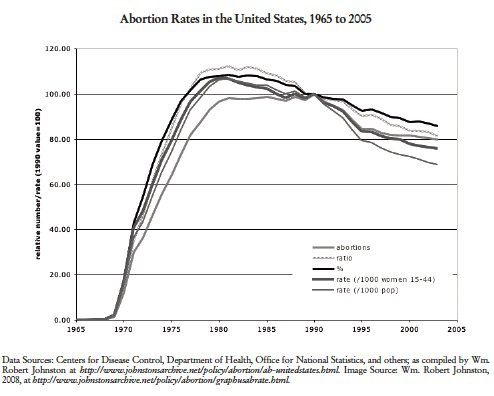
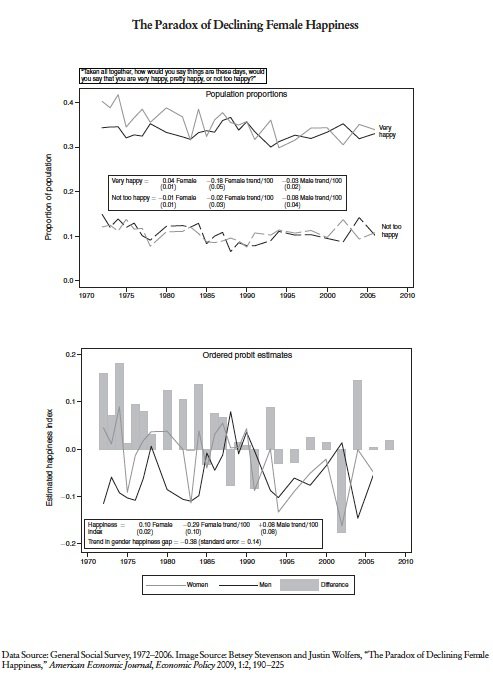
Stevenson and Wolfer’s interpretation of the data is striking.
To compare this
change with other well-known shifters of the happiness distribution, we
can consider how large an increase in unemployment would be needed to
generate a similar shift in subjective well-being. In a related
context, Wolfers (2003) regressed individual happiness measures against
a state’s unemployment rate, controlling for state and year fixed
effects, finding that a one percentage point rise in a state’s
unemployment rate leads to a decline in happiness of 0.015 points. The
ratio between these two estimates suggests that the relative decline in
the subjective well-being of U.S. women over the past thirty-five years
is roughly comparable to the effects of an 8.5 percentage point rise in
unemployment (that is, a rise from, say 4 percent unemployment to 12.5
percent) . . . . Across a range of ordered probit regressions of
happiness or life satisfaction on the log of GDP per capital, Wolfers
(2006) finds coefficient estimates of around 0.2, suggesting that the
relative decline in women’s well-being over the past 35 years is
equivalent to them having enjoyed none [emphasis added] of the
accumulated gains due to economic growth.
The impact of this redistribution of welfare is profound—and alarming.
Societies are structured around many objectives, but one of their chief
reasons to be is the protection of the weak. This means the old, the
young, and childbearing and childrearing women. Contraception
undermines this fundamental imperative, and, in so doing, undermines
the legitimacy of the social contract. When the social fabric of a
society is geared to move welfare from the weak to the strong, rather
than the other way around, it cannot survive in the long run.
Contraception as a
Prisoner’s Dilemma
If the arguments above are true, why do women agree to use
contraception? More pointedly, why are so many women so vocal that
contraception is a necessity—indeed, that it is their birthright?
The answer is that contraception sets up what game theorists refer to
as a “prisoner’s dilemma.” The idea is a simple and powerful one. A
prisoner’s dilemma is any social setting wherein all parties have a
choice between cooperation and noncooperation, and where all parties
would be better off if they choose cooperation. But because people in a
prisoner’s-dilemma setting cannot effectively coordinate and enforce
cooperation, all parties choose the best individual choice, which is
noncooperation. The social result is disastrous, and everyone is made
poorer.
A standard example of a prisoner’s dilemma is conservation of a common
pool resource, such as ocean fisheries. Over the long run, all
fishermen would be better off harvesting fish at a sustainable rate.
But an individual fisherman knows that whether or not others harvest at
a sustainable rate, he is better off “cheating” and harvesting more
than he should. In other words, if I am a fisherman, and other
fishermen harvest sustainably, I am better off “free riding” on their
conservation efforts and grabbing more than they do. If, on the other
hand, other fishermen cheat, I am also better off cheating because I
have to get what I can while I can. Since all fishermen understsand
this, absent either regulation and enforcement or very strong social
mores, the result is the classic “tragedy of the commons,” whereby all
fishermen overfish the resource and it disappears.
Contraception is structurally similar to this. Imagine that, before the
invention of contraceptive technology, a “state of nature” exists
wherein men and women couple in a single mating market. The mating
market, as discussed earlier, is by definition populated by roughly
equal numbers of men and women. Again, the bargaining positions of men
and women in this market are roughly equal.
Imagine, then, that chemical contraceptive technology is invented, and
women suddenly face the choice of using contraception or not. Imagine
the situation faced by younger women. Younger women who choose to use
contraceptive technology now find themselves able to enter the sex
market wherein they are the “scarce resource” and can command a high
price for their services, relative to men. By contrast, young women who
do not enter the sex market find themselves unable to benefit from the
higher prices paid in the sex market and face a decrease in their share
of the gains from marriage because they now are in relative oversupply
in the marriage market. The situation faced by young women is
straightforward: Not entering the sex market means an unambiguous
reduction in their total lifetime welfare, whereas entering means that
the reduction of welfare in the marriage market can be partially offset
by high bargaining power in the sex market. Thus, the invention of
contraceptive technology means that the optimal decision for young
women is to enter the sex market and remain there for as long as
possible, despite the fact that the new equilibrium may be worse, over
the total life cycle, for women.
In short, women (and, by implication, children) would be better off had
there been no separation of the mating market into separate sex and
marriage markets. Contraceptive technology sets up a prisoner’s
dilemma, under which all women have an incentive to use contraception
and enter the sex market in their early adult years. Given the dynamics
described in this essay, this shifts welfare away from women and toward
men in the marriage market, and also intertemporally shifts women’s
welfare from their later, childbearing years toward their earlier,
nonchildbearing years.
As economists know well, prisoner’s dilemmas are exceedingly strong
social equilibria. Absent very powerful social mores or laws, against
the behavior that leads to prisoners’ dilemmas, they are nearly
impossible to avoid. This explains the seeming paradox that women both
demand contraception and are made worse off by it.
Of course, this leads immediately to the question: Is there a way out?
Certainly, an adequate treatment of this question is beyond the scope
of this essay. A few points merit mention here, however.
First, we know that social mores can, if strong enough, defeat
prisoner’s-dilemma outcomes. We also know that some religious
institutions (namely, the Catholic Church) continue to maintain the
teaching that contraception is harmful. In most dioceses, the Church’s
teachings on contraception receive almost no treatment from the pulpit
and are given an hour or two during a marriage-preparation classes.
Given the centrality of the issue, and the centrality of sexuality, to
the human person, this is not an acceptable situation.
What is needed is a movement of “new feminism” based on a deep
understanding of the nature of woman and her role at the center of
society. This is already under way, as important organizations such as
ENDOW (Educating on the Nature of Dignity of Women) follow in the
footsteps of John Paul II by providing an intellectual foundation for
an authentic feminism. This may, in the long run, be one of the most
important cultural developments of our time.
Timothy Reichert
is an economist living in Denver.
|

